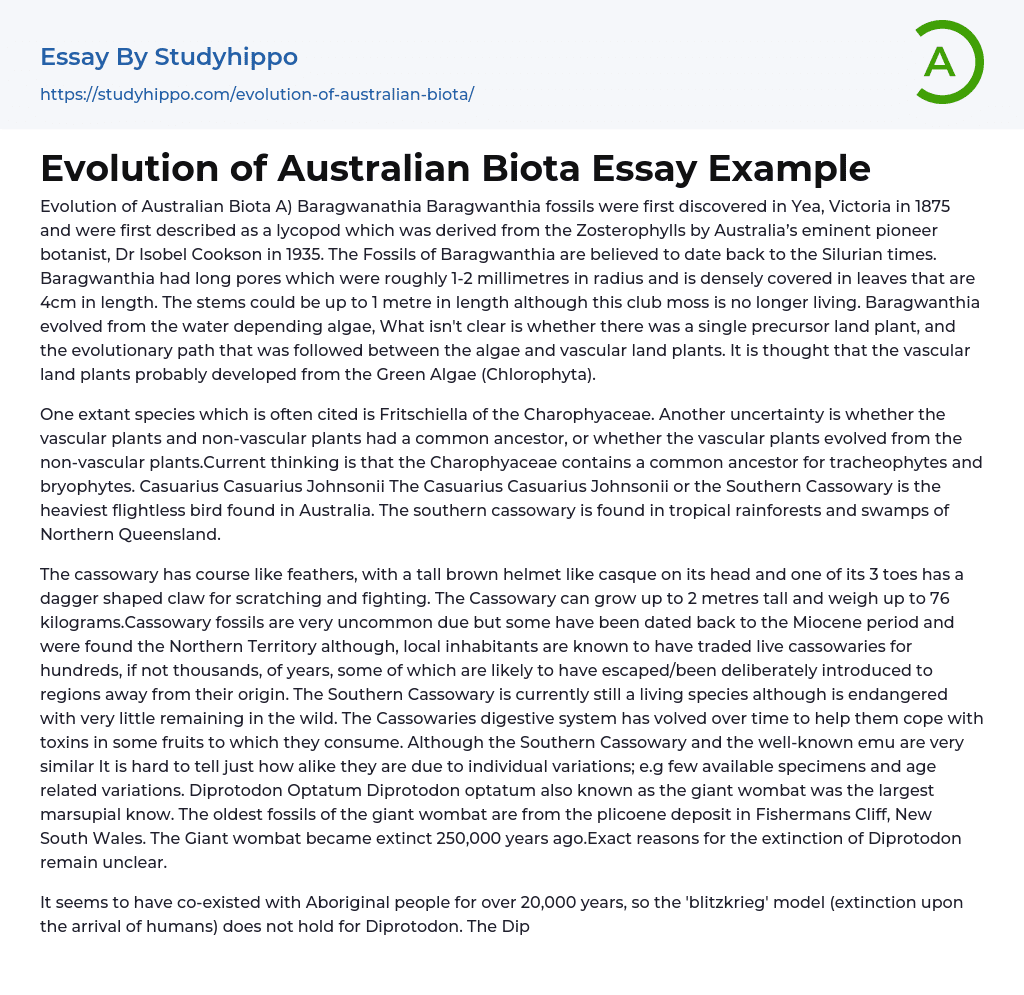The discovery of Baragwanthia fossils in Yea, Victoria in 1875 led to their description as a lycopod by Dr Isobel Cookson, an important early botanist in Australia. These fossils are thought to originate from the Silurian era.
Baragwanthia, a club moss, had long pores measuring approximately 1-2 millimetres in radius and was densely covered in 4cm long leaves. While no longer alive, the stems of Baragwanthia could grow up to 1 metre in length. The evolution of Baragwanthia from water-dependent algae is still not fully understood. It remains unclear if there was a single precursor land plant and the exact evolutionary path that led from algae to vascular land plants. However, it is believed that vascular land plants likely originated from Green Algae (Chlorophyta).
One extant species often mentioned is Fritschiella of the Charophyaceae. It remains uncertain whether vascular plants and
...non-vascular plants share a common ancestor or if vascular plants evolved from non-vascular plants. The current belief is that the Charophyaceae contains a shared ancestor for tracheophytes and bryophytes.
Casuarius Casuarius Johnsonii, also known as the Southern Cassowary, is Australia's heaviest flightless bird. It resides in Northern Queensland's tropical rainforests and swamps. The Southern Cassowary possesses rough feathers and a tall brown casque on its head. Its third toe boasts a claw shaped like a dagger for scratching and fighting. It can reach heights of 2 meters and weigh up to 76 kilograms.
Cassowary fossils are rare but some have been dated back to the Miocene epoch, discovered in the Northern Territory. However, local inhabitants have been trading live cassowaries for hundreds, if not thousands, of years. Consequently, it is likely that some of these birds either escaped
or were intentionally introduced to regions beyond their original habitat.
The Southern Cassowary, an endangered species with a small population in the wild, has developed a digestive system that can handle toxins found in specific fruits it consumes. While both the Southern Cassowary and the popular emu share similarities, telling them apart can be challenging due to variations among individuals, limited specimens available for study, and age-related discrepancies. Another notable marsupial is Diprotodon Optatum, commonly referred to as the giant wombat - it held the title for being the largest known marsupial.
The giant wombat, known as Diprotodon optatum, is estimated to have lived up to 250,000 years ago according to the oldest fossils found in the plicoene deposit at Fishermans Cliff, New South Wales. Despite co-existing with Aboriginal people for over 20,000 years, the exact reasons for the extinction of Diprotodon remain unclear and contradict the 'blitzkrieg' model of extinction upon human arrival. This massive creature could reach impressive sizes, measuring up to 3.8 metres in length and 1.7 metres wide at the shoulders.
The giant wombat preferred semi-arid plains, savannahs, and open woodlands but was not commonly found in hilly, forested coastal areas. However, it was also known for its preference for coastal locations. Many experiments have confirmed the relation between the Diprotodon Optatum and the Common Wombat, based on similarities in their feet, skull, and jaw shapes. B) The sources used for this assessment were reliable and valid. I cross-checked all sources to ensure data alignment, and if discrepancies arose, I delved deeper into the topic. I primarily relied on reputable websites such as museums rather than relying on sites like Wikipedia. C)
- Tree essays
- Seed essays
- Agriculture essays
- Albert einstein essays
- Animals essays
- Archaeology essays
- Bear essays
- Biology essays
- Birds essays
- Butterfly essays
- Cat essays
- Charles Darwin essays
- Chemistry essays
- Dinosaur essays
- Discovery essays
- Dolphin essays
- Elephant essays
- Eli Whitney essays
- Environmental Science essays
- Evolution essays
- Fish essays
- Genetics essays
- Horse essays
- Human Evolution essays
- Isaac Newton essays
- Journal essays
- Linguistics essays
- Lion essays
- Logic essays
- Mars essays
- Methodology essays
- Mineralogy essays
- Monkey essays
- Moon essays
- Mythology essays
- Noam Chomsky essays
- Physics essays
- Plate Tectonics essays
- Progress essays
- Reaction Rate essays
- Roman Numerals essays
- Scientific essays
- Scientific Method essays
- Scientist essays
- Seismology essays
- Space Exploration essays
- Stars essays
- Sun essays
- Thomas Edison essays
- Tiger essays




